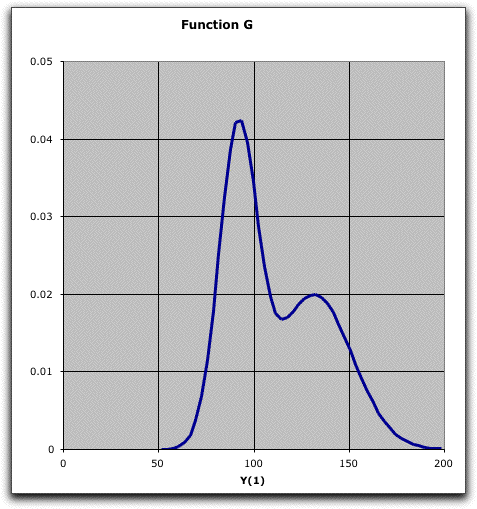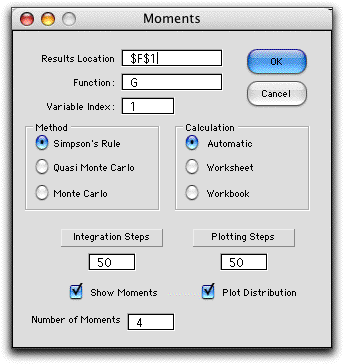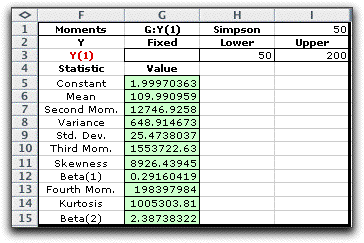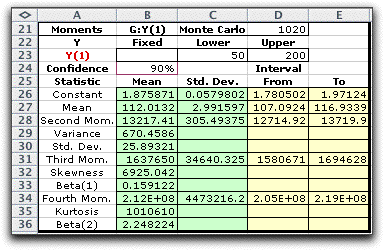|
A graph of the function shows two peaks. This
might describe a mixture of two separate populations. The graph
was created by the add-in.

This is not a true probability distribution because
the area under the function is not 1, but rather approximately
2. We have truncated the distribution so that the entire mass
lies between 50 and 200.
Although it may be possible to analytically determine
the moments of this distribution, the add-in uses numerical
integration to compute them. A dialog presented by the Moments
command accepts data for the results location
for the display, the name of the function, the variable
index (important when there is more than one variable),
the integration method, and the calculation
option. The integration steps is the number of observations
for the numerical integration. The plotting steps is
the number of points that will be included in the plot of the
function. The number of moments determines how many
will be computed or displayed. The number must be between 1
and 4. Checkboxes determine whether moments and/or plot are
displayed.

Moments computed with Simpson's Rule from 50 observations are
placed on the worksheet.

The exact moments have the following definitions.
We use f for the general function and x for
the general variable. The variable is bounded by a
and b.
If the function is a probability distribution,
the constant term is 1. Otherwise the constant term adjusts
the distribution for the calculation of the moments. The mean,
variance and standard deviation are well known characteristics
of distribution functions. The skewness, as indicated by Beta(1),
measures the symmetry of a distribution. Symmetric distributions
have a skewness of 0. If the mass of the function is concentrated
to the left of the mean and the distribution has a tail that
decreases to the right, the skewness is positive, as for the
example. Negative skewness indicates that the greater mass is
to the right and the tail is to the left. The kurtosis measures
the relative thickness of the tails of the distribution. The
value of Beta(2) is 3 for a Normal distribution.
The add-in approximates the integrals associated
with the moments using one of the numerical integration methods.
When one of the Monte Carlo methods is used, estimates of the
error variance are obtained and used to construct confidence
intervals for the moments. The confidence intervals for measures
computed by combining moments are difficult to calculate and
are not presented. The intervals change with the Confidence
value in cell B24. Since all the integrals use the same observations,
estimates of the different moments are not independent.

The Moments dialog provides an opportunity
to plot the function. The plotting program collects the functional
values used to compute the moments. The range is divided into
a number of intervals and the average function value within
each interval is computed. Points are plotted at the mid-points
of the intervals. The graph below is constructed for the example
using Monte Carlo sampling with 1020 observations divided into
50 intervals. For the Monte Carlo methods, there must be many
more observations than intervals for a smooth graph. When using
Simpson's Rule with one dimension, the number of observations
must be no less than the number of intervals for the graph.

|



